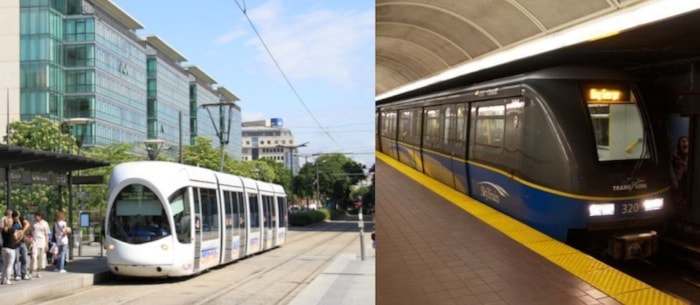New rapid transit studies released by TransLink have handed more ammunition to backers of SkyTrain technology through Surrey to Langley as well as on Vancouver's Broadway corridor toward UBC.
A SkyTrain line running above Fraser Highway from Surrey City Centre to Langley, coupled with Bus Rapid Transit (BRT) lines running south to White Rock on King George Boulevard and east to Guildford on 104 Avenue is the most expensive of four short-listed options at $2.22 billion, but TransLink found it delivers the most transportation benefits and by far the highest ridership.
It would also be the fastest, carrying passengers from Langley to Surrey Central station in just 22 minutes, compared to 29 or 30 minutes for the other three options.
Surrey council has lobbied for a network of ground-level light rail (LRT) lines, rather than BRT or elevated SkyTrain, arguing LRT would be a better fit for the city's neighbourhoods.
TransLink previously studied a dozen different technology permutations in Surrey before winnowing them to the four front runners.
The option closest to the city's preference would run light rail trains on all three corridors radiating from downtown Surrey, with BRT rapid buses running on the southern section of King George from Newton to White Rock as light rail isn't considered justifiable there.
At $2.18 billion, that would be only slightly cheaper than the SkyTrain/BRT option, but is estimated to attract only half the new transit riders as SkyTrain because light rail trains run more slowly and less reliably at street level with traffic.
The main downside of SkyTrain is the elevated guideway down Fraser Highway would be an eyesore, while BRT and LRT offer more scope to improve urban design.
Surrey transit advocate Paul Hillsdon, who previously backed light rail, now prefers the SkyTrain option (with BRT running to Guildford, Newton and White Rock), adding it clearly outperforms LRT at virtually the same cost.
"Based on the cost, there seems to be very little benefit to pursuing the light rail system as the city has advocated," Hillsdon said.
He added TransLink may have inflated the light rail costs somewhat compared to systems built elsewhere, but he accepts the findings.
"There are huge travel time savings with SkyTrain and double the ridership, for basically the exact same price."
But he said SkyTrain on Fraser Highway would depend on neighbourhood acceptance of denser development – SkyTrain could bring high-rise towers, not just mid-rises, to Fleetwood and Clayton.
Despite the city's goal of densifying King George, Hillsdon noted that hasn't happened, while growth has concentrated in areas like Clayton and Grandview instead.
BRT, which delivers the southern leg to South Surrey/White Rock in all options, does not simply mean adding more buses.
A BRT line would run high-capacity articulated buses in their own dedicated lanes, with traffic priority – functioning much like a light rail system on rubber wheels instead of tracks.
Surrey Coun. Barinder Rasode said council definitely wants light rail, not just express-bus BRT, on King George to densify that corridor, in line with city plans.
"We've been very clear that our option would be LRT, not just because of the cost but because it is less intrusive to the community," Rasode said.
Light rail passengers riding at street level would be more likely to stop and shop at Surrey businesses, she said, than an overhead Skytrain whisking residents to other cities.
"It's about economic investment in our own city," Rasode said. "We don't want mass rapid transit running right out of the city every time. We don't want people to just be transported straight out to Langley."
The $2.18-billion LRT scenario would still require passengers arriving from South Surrey and White Rock on BRT buses to transfer to trains in Newton.
A cheaper option, at $1.68 billion, would run light rail on Fraser Highway to Langley and BRT on the King George and 104 corridors.
The cheapest scenario still on the table is running BRT on all three corridors at a cost of $900 million.
Also released was a study of options for rapid transit on Vancouver's heavily congested Broadway corridor to UBC.
Again, the most expensive option – a $3-billion underground SkyTrain line down Broadway – also ranks as having the highest benefit, most ridership and best speed and reliability.
At-grade LRT could be built to UBC for $1.1 billion, while tunnelled LRT or a combo LRT/subway scenario could run $1.4 to $2.7 billion.
TransLink plans to lead regional discussions with the public, elected officials and other stakeholders to examine the trade-offs of the options and decide on preferred options for the Surrey and Vancouver expansions.
"We're not picking one over the other," said Bob Paddon, TransLink's executive vice-president of strategic planning and public affairs. "We're nowhere near identifying a preference."
Paddon said the short-listed options perform differently depending on what criteria is considered and the goals of the local communities, adding more detail on TransLink's findings will be released in the weeks ahead.
Nor is it clear yet how either new transit line will be financed.
Area mayors are pressing the province for new funding sources for TransLink, but Paddon noted there would also have to be large capital contributions to the new lines from the federal and provincial governments.
"You can't do rapid transit without senior government involvement."
No decision has been made on whether a Surrey or Vancouver rapid transit expansion should be built first.
Four options short listed for Surrey

Option 4 (SkyTrain to Langley + BRT)

